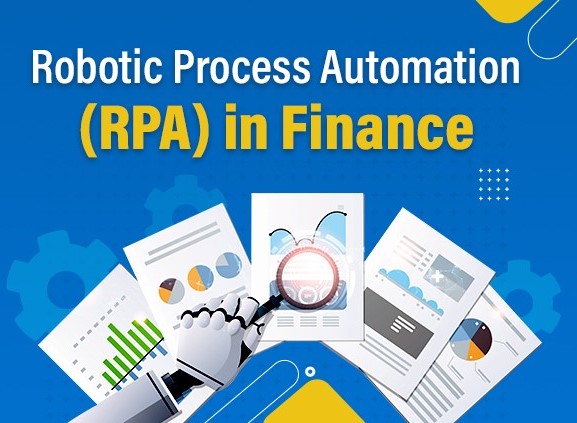RPA Implementation in Finance
A large global financial services firm was facing challenges with high operational costs, slow processing times, and frequent errors in manual data handling. The firm managed a vast amount of data across various departments, including accounts payable, accounts receivable, and compliance reporting.
Objectives
The firm aimed to:
- Increase operational efficiency.
- Reduce processing time for financial transactions.
- Minimize human errors in data entry and reporting.
- Enhance compliance with regulatory standards.

RPA Implementation
The firm decided to implement RPA across several key processes:
- Invoice Processing:
- Before RPA: Manual data entry from invoices into the accounting system took hours, leading to delays and errors.
- After RPA: Bots were developed to extract data from invoices, validate it against purchase orders, and automatically input it into the system. This reduced processing time from days to mere hours.
- Reconciliation of Accounts:
- Before RPA: Monthly reconciliations required significant human intervention, often leading to discrepancies.
- After RPA: Bots automated the comparison of transaction records against bank statements, flagging discrepancies for review. This improved accuracy and reduced the time taken for reconciliations by 50%.
- Regulatory Reporting:
- Before RPA: Generating reports for regulatory compliance involved collecting data from multiple sources and manual compilation.
- After RPA: Automated scripts gathered data, compiled reports, and ensured timely submission, significantly reducing the risk of non-compliance and improving report accuracy.
Result
- Cost Savings: The firm reported a 30% reduction in operational costs related to the automated processes.
- Efficiency Gains: Processing times were cut down by 70%, allowing staff to focus on more strategic tasks rather than repetitive data entry.
- Error Reduction: Data entry errors dropped by over 90%, leading to more reliable financial reporting.
- Scalability: The firm was able to quickly scale RPA solutions to other departments, further amplifying the benefits.
Challenges and Lessons Learned
- Change Management: Initial resistance from staff required effective change management strategies, including training and communication about the benefits of RPA.
- Continuous Improvement: Ongoing assessment of RPA performance and adapting bots to changing business needs proved crucial for sustained success.
- Integration with Existing Systems: Ensuring that RPA tools seamlessly integrated with legacy systems was a key challenge that required careful planning.
Conclusion
The implementation of RPA transformed the firm’s finance operations, resulting in significant cost savings, improved accuracy, and enhanced compliance.
The success of the initial projects paved the way for broader adoption of automation technologies across the organization.
RPA Implementation in HR
XYZ Corporation, a mid-sized manufacturing company, was facing challenges in its HR processes, particularly in recruitment, onboarding, and payroll management. Manual processes were time-consuming, prone to errors, and resulted in employee dissatisfaction due to delays.

Objectives
- Improve Efficiency: Reduce the time taken for HR processes.
- Enhance Accuracy: Minimize human errors in data entry and processing.
- Free Up HR Staff: Allow HR personnel to focus on strategic tasks rather than repetitive administrative work.
RPA Implementation
- Process Identification:
- Recruitment: Screening resumes, scheduling interviews, and sending notifications.
- Onboarding: Document collection, background checks, and system updates.
- Payroll: Data entry for attendance, leave management, and calculations.
- Tool Selection:
- XYZ Corporation selected an RPA tool (e.g., UiPath) that integrates seamlessly with their existing HR systems.
- Development and Testing:
- RPA bots were developed to automate the identified tasks. Extensive testing ensured they functioned correctly and securely.
- Deployment:
- The bots were deployed in phases, starting with recruitment, followed by onboarding and payroll.
- Training:
- HR staff were trained on how to work alongside the RPA bots, focusing on exception handling and strategic initiatives.
Result
- Efficiency Gains:
- Recruitment time was reduced by 50%. The bot screened resumes in minutes instead of days.
- Onboarding time was cut by 40%, with bots managing document collection and data entry.
- Improved Accuracy:
- Error rates in payroll processing decreased by 80%, significantly reducing compliance risks.
- Enhanced Employee Satisfaction:
- HR staff reported higher job satisfaction, as they could focus on employee engagement and strategic planning rather than mundane tasks.
- Cost Savings:
- The company estimated a cost reduction of 30% in HR operational expenses due to increased efficiency and reduced errors.
Challenges and Lessons Learned
- Change Management: Some staff were resistant to the new technology, fearing job loss. This was addressed through communication and training.
- Integration Issues: Initial integration with legacy systems posed challenges, requiring additional IT support.
Key Takeaways
- RPA can dramatically streamline HR processes.
- Proper change management and training are essential for successful implementation.
- Focusing on strategic HR activities post-automation can drive greater organizational value.
This case study illustrates how RPA can transform HR functions, making them more efficient and effective.
Conclusion
The implementation of RPA in XYZ Corporation’s HR department led to significant improvements in efficiency, accuracy, and employee satisfaction.
By automating repetitive tasks, the HR team could redirect their efforts towards more strategic functions, ultimately benefiting the organization as a whole.
The success of this initiative prompted the company to explore RPA applications in other departments as well.
RPA in Supply Chain Management
Robotic Process Automation (RPA) is increasingly being adopted in supply chain management to streamline operations, reduce costs, and enhance efficiency. This case study examines how a leading consumer goods company implemented RPA to optimize its supply chain processes.

Goals
- Reduce Order Processing Time: Automate repetitive tasks to speed up order fulfillment.
- Improve Inventory Accuracy: Enhance inventory tracking and management through automation.
- Streamline Supplier Communication: Automate data entry and communication with suppliers to minimize errors.
RPA Implementation
- Order Processing Automation:
- Before RPA: Manual data entry for orders took an average of 2 hours per order, with high error rates.
- After RPA: Implemented RPA bots to automatically extract order details from emails and input them into the ERP system, reducing processing time to 15 minutes per order and decreasing errors by 90%.
- Inventory Management:
- Before RPA: Inventory levels were tracked manually, leading to discrepancies and stockouts.
- After RPA: RPA tools were deployed to monitor inventory levels in real-time, automatically generating alerts for low stock and initiating reorders. This improved inventory accuracy to 98% and reduced stockouts by 30%.
- Supplier Communication:
- Before RPA: Communication with suppliers was fragmented, with manual follow-ups often resulting in miscommunication.
- After RPA: Automated workflows were created for sending purchase orders and confirmations. Bots managed follow-ups, ensuring timely communication and a 40% reduction in lead times.
Outcomes
- Cost Savings: The company achieved a 25% reduction in operational costs related to order processing and inventory management.
- Increased Efficiency: Overall process efficiency improved, allowing the supply chain team to focus on strategic initiatives rather than repetitive tasks.
- Enhanced Customer Satisfaction: Faster order fulfillment and better inventory management led to improved customer service levels.
Challenges and Lessons Learned
- Change Management: Employees were initially resistant to RPA adoption. Training sessions and clear communication about the benefits helped ease the transition.
- Integration with Existing Systems: Ensuring that RPA tools seamlessly integrated with legacy systems required additional resources and time.
Conclusion
The implementation of RPA in the supply chain significantly enhanced operational efficiency, reduced costs, and improved customer satisfaction for the consumer goods company.
As the market continues to evolve, RPA offers a scalable solution for organizations seeking to optimize their supply chain processes.
Future plans include expanding RPA applications to other areas such as procurement and logistics.
Key Takeaways
- RPA can transform supply chain management by automating repetitive tasks.
- Successful implementation requires addressing change management and integration challenges.
- Continuous evaluation and scaling of RPA applications can lead to sustained improvements and innovation.







